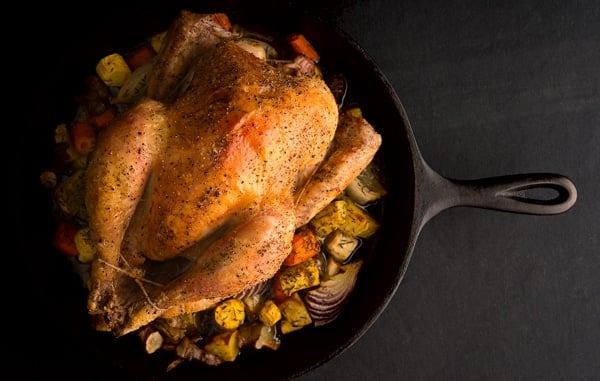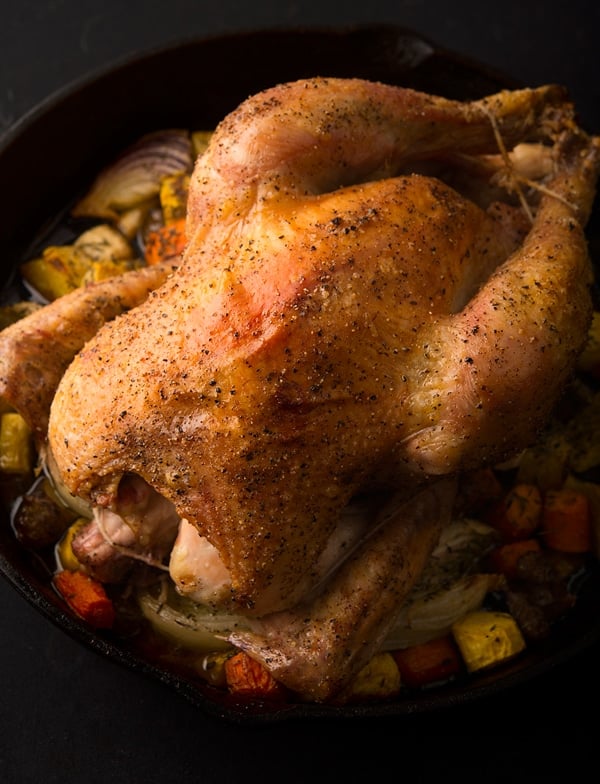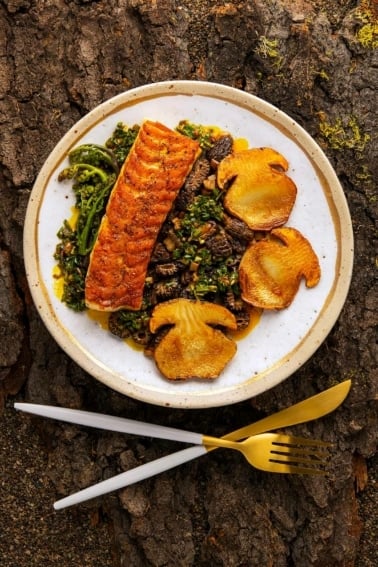As an Amazon Associate I earn from qualifying purchases.

I bought a chicken the other day. To virtually every other American, this is an event akin to taking out the trash, or driving to work — a commonplace barely worth noting. But there’s something you should know: I have not bought meat for the home more than a handful of times over the past decade. So buying any meat is very much an event for me. You might ask why on earth, of all the things that I could have chosen to break my self-imposed fast on domesticated meats, would I buy a chicken?
Because of all the flavors I miss from the store-bought world — ribeyes, skirt steak, a huge pork chop, shrimp — chicken is the one I long for most often. Chicken. You read that right. Chicken deserves respect. It deserves to be reclaimed by the culinary world for what it has been for most of human history: A bird worthy of a king’s table, a gift for cooks to work magic on. A platter of home.
How Americans came to believe that $1 a pound chicken is as inalienable a right as free speech or the right to bear arms is a depressing story of industrial might over right. Suffice to say that when Frank Perdue said it took a tough man to make a tender chicken, he was right. He and his colleague John Tyson needed to be OK with debasing a once prized bird, to polluting environments and destroying whole communities. The industrial chicken is a wretched shadow of its former self. To paraphrase J.R.R. Tolkien: “they were chickens once… tortured, and mutilated… a ruined and terrible form of life…now perfected.”
The modern chicken has a breast so big it can barely walk or fly. It’s lethargic, to the point where even if a farmer gives it pasture to roam it won’t. It grows with frightening speed: In 1960 it took about 5 months to raise a meat chicken for market. Now it can be done in 6 weeks. In 1925, a chicken needed to eat 4.7 pounds of feed to gain 1 pound. Now it only needs to eat 1.9 pounds of feed to gain the same pound. Only tilapia, the Soylent Green of fish, has a better feed ratio.
This is the chicken you eat. And we Americans eat a lot of it. Chicken topped beef as America’s favorite meat in 1992. In 2006 we ate an average of 87.7 pounds of these birds, the highest poundage on record. And as you well know, we are not eating all this chicken as a whole bird.
Various shreds of it are glued together to make your McNugget. It’s injected with a saline solution to “plump” it and make the watery, flabby, tasteless meat even more tender; apparently teeth are no longer needed to enjoy your skinless, boneless chicken lump. it’s sliced and diced in so many ways that the concept of roasting a whole chicken — once a bedrock skill every cook possessed — is now so daunting it’s a challenge on Top Chef. (Incidentally, chicken used to be almost always sold whole, with the head and feet on, right up into the 1950s. Why? Consumers judged chickens like fish: Are the eyes clear? Feet fresh looking? People knew what a good chicken looked like. Now if you did that you’d create an incident, unless you are at an Asian market. )
No wonder the average consumer recoils in horror at the notion of $5 a pound chicken. Chicken has become our baseline, our lowest common denominator of meat. It’s our daily bread, a right like free bread in ancient Rome or free gas in modern Saudi Arabia.
This, you should know, is a fairly recent state of affairs. By rights, chicken should indeed cost about $5 a pound. If you recall your high school history or are very old, you will remember President Herbert Hoover promising “a chicken in every pot” should we elect him to the Oval Office. Modern readers of that quote are mystified. A chicken in every pot? So what?
Well, as it happens, a chicken was a big deal in 1928, when Hoover spoke those words. If you adjust for inflation, a chicken cost about $5.85 a pound in 1928, down from about $8.23 a pound in 1923, when Delaware farmers first started shipping live chickens to New York City to serve the Jewish market. Incidentally, in those days a beef rib roast cost about $5.24 a pound, in today’s dollars.
Flash forward to 1946. Chicken was — again, adjusted for inflation — $5 a pound. Ditto in 1960. Even as late as 1980, two decades after the “chicken revolution” had begun, the adjusted price for a whole broiler was $4.51. And mind you, that 1980 chicken was nearly as terrible as today’s. A series of industry “improvements,” slower rates of inflation and booming demand hammered the price down to its nadir, $1.04 a pound in 2004. Costs have risen mildly since then.
The industrial chicken is not going anywhere. It is part of our national fabric, and I am definitely not saying that the crappy chicken you buy at the nearest mega-mart should cost $5 a pound. That is indeed crazy. But it’s not the only chicken in town.
Not every farmer bought into the chicken revolution. Some farmers kept raising stouter, hardier breeds of birds the way they always had. Perhaps the biggest reason for my choice of a chicken is because I have vivid memories of astonishingly good chicken during my childhood. Thirty years ago, my mom, whose family raised chickens when she was a little girl, bought broilers from a place called Gage’s Chicken Farm in New Jersey. Real chickens. Big, strong, fat, yellow and plump. These were special occasion chickens, to be roasted whole, carcass made into soup.

There are many such farmers today. You’ve seen them at the farmer’s market. Some of them are my friends, including the folks at Dinner Bell Farms, where I bought this chicken. They have gleaned all the good from the modern chicken industry and applied it to decent husbandry of their meat chickens, producing a superior product. And, by and large, they charge between $4 and $9 a pound for their birds.
Mostly people understand that this is a weekend chicken, so things go smoothly. But a significant minority of shoppers heap derision on them for their prices. I don’t know a single small farmer who doesn’t have a horror story about customers giving them shit for charging even $3 a pound, let alone $9. (This story, from my friends Christian and Kate in Michigan, is especially good.) Fer chrissake, I once watched a woman happily pay $4 a pound for heirloom tomatoes walk over to the chicken vendor and give him a raft of crap for daring to sell chicken at $4.50 a pound. The disconnect would be amusing were it not so sad.
It’s worth repeating: The chickens you buy at the farmer’s market are not the same birds as you buy from even fancy supermarkets. They’re not even the same things as the Mary’s or other mass-market “organic,” free-range, whatever-whatever chickens you buy in the store. They are something entirely different. At worst, they are superior birds at the table. At best, they are downright magical.
Denser, meatier, fatter, and so much fuller in chicken flavor that one perfectly cooked bite will ruin you on the mass market dreck forever.
Yes, they are expensive. They are not for everyday meals, unless you are in the tax bracket to afford $30 chickens routinely. But consider this: Many of you will happily pay $30 a pound for wild-caught salmon. Or $9 a pound for a goose, or hell, even the $15 a pound for regular commodity ribeyes you get in the supermarket.
Chefs, you too are to blame. Most of you hate chicken, with good reason if you are talking about industrial birds. You shrug off chicken as trash meat, uninteresting, something you are forced to cook for the unwashed, civilian, tin-palate masses. What you really want to cook is pork. And not just any pork. So-called heritage breeds, the Berkshires, Durocs, Tamworths and such, are darlings in the culinary world. Well, there are just as many heritage breeds of chicken, too.
I hear ya. You’ll need to charge $30 an entree if you use good chickens. I get food costs. But restaurants are where change happens in food, and they are places where people have special occasions. If you can play up the farmer on your pork chop, you can for your chicken, too.
It will take time, and the continuing efforts of farmers like Molly Nakahara and Paul Glowaski of Dinner Bell Farm, to swing the pendulum. And it will also take you and me. Seek out a real chicken. Roast it whole. Make soup from the carcass. Use every bit. Revel in a plate of home.




I also love the details you can glean if you have an opportunity to visit a farm where “real” chickens are raised. Knowing the farmer and the heart they put into it makes it taste even more special.
Thank you so much for this essay. We are just starting to raise our own meat chickens and are working toward not buying at the supermarket anymore. We’ve tried Dorking, barred rock, and a friend’s Cornish cross. So far I like the cross between barred rock and silver laced Wyandotte. What heritage breeds do folks like best? I’m thinking of ordering some gray ranger broilers.
You have convinced me I will seek out a good local chicken and report back
Kind Sir… Thank you from the bottom of my heart! With warm regards from a small chicken farmer in CA.
Lisa
Would love to hear your thoughts on other chickens too, Hank, specifically the capons and roosters we rarely eat in North America.
The closest I’ve seen are the stewing hens in Asian supermarkets (frozen) and occaisionally in some regular supermarkets (fresh).
Chanman: Love stewing hens and roosters! And it’s been a while since I ate a capon, but I remember it was good.
Spot on article as usual Hank. Thanks for tackling the issue.
I think a creative, if not downright misleading, marketing strategy is in order here… Let’s not call the quality birds “chicken” at all!
“Squab” vs. “pigeon” is a prime example of the power in a name.
How about:
Domesticated game bird?
Country Chanticleer?
What’s in a name?… Everything!
Great essay … I have been a lurker form some time – always looking forward to your posts.
What I am really interested in, other than raising chickens … the recipe for the bird in that photo. It looks delicious!
Alex: I just used Thomas Keller’s recipe for roast chicken. You can find it here: https://www.simplyrecipes.com/recipes/kellers_roast_chicken/
Thanks for the great article. I’m a cook in San Francisco and I couldn’t agree more that chefs are at least somewhat to blame for the reputation of chicken. Chefs never like to cook anything when they feel “It has to be on the menu”, it is not only about food cost, but this old idea of what diners expect to be on the menu when going out; The chicken, the fish, the steak, the pasta, the veg option, thank god this is beginning to change across the board.
Our most famous dish at the restaurant is a simple roast chicken, a heritage breed bird roasted whole with a simple sauce. I love that they come in from our two farmers in all shapes and sizes, from sleek little 2.5 pounders, to plump round 4+ pounders for a whole family. I live for tasting that sauce, some reduced stock, marsala and a bit of cream, or the little bit of skin that may fall off while carving, or the watching someone try it from the open kitchen, their head rolling back, fork and knife dropping to the table. I invite you any night you would like Hank Shaw to come down to the Bay and eat some roast chicken. As they say, food is always better when someone else is cooking.
Hank, this is beautiful. *FIVE* of our pastured poultry customers separately forwarded me your essay. You may delegate change-making to the chefs, but people like you make a difference too. Thanks for sharing the beautiful story of REAL chickens!
I buy the 5.99 chickens, usually. Everyone needs a little hypocrisy in their lives, and the cheap chicken is mine.
The skin tastes good, and I eat the leg, and I usually have drank enough wine to dull my taste buds….but it still leaves me with blue balls of the culinary kind….its just not that great. Its a bit of a letdown. The breast absolutely has no soul. Its just anonymous meat.
but I’ve always argued what you just did. If someone wanted me to hatch, raise and feed a chicken, protect it from predators, then slaughter it, pluck it, clean it, cook it and put in a fancy plastic container, then there is no way in hell that I would do it for 6 bucks.
Great article man, Im gonna see what I can dig up around here at the farmers markets
I’m going to take a cowardly middle position. I generally do not buy factory farmed chickens and they are usually Cornish Cross. Having eaten birds like Poulet de Bresse I feel there are tiers of quality. Bland factory farmed chickens taste nothing like free range organic Cornish Cross, but superior flavored birds exist and it’s usually heritage breeds that have that additional flavor.
Here in the Philippines, commercial broilers are harvested at 28 days. The aim is for the highest percentage of fully dressed birds at 1.00 to 1.1 kg(neckless, no giblets) which is for the institutional market. Freeze them and you get “black bone” upon cooking. You need MSG to make them edible.
Great post. I’ve been telling friends for years to use our local poultry provider from our farmer’s market. I couldn’t put my finger on it at the time but their chicken, everything from boneless breasts to roasters) just tasted better than even premium organic from the supermarket (which also cost more, btw!). After talking to them and with some of the points you made here, it makes more sense.
Another trick if you have a freezer – oftentimes these folks provide food to restaurants and if you have the space, inquire about getting the “restaurant rate” if you buy in quantity. It can save you a bit and make sure you get through the winter if your farmer’s market closes seasonally.
Great article!
Hank, I love your website, but i have some serious issues with some of the assertions you have on the subject of chicken. Everyone here that’s actually raised chickens raise your hands. if you haven’t, it’s worth going through the process once before form too many opinions about breeds and processes.
I think this debate can be broken down into a few salient points:
cost for poultry: agreed – even the cornish x birds that go to market are sold outrageously cheap – the low margin is indicative of the quality of life and food that these birds get. I raise pastured cornish cross for meat, and I get *at best* a 3.5:1 feed:meat ratio. These, after all, are pastured cornish that supplement upwards of 30% of their diet on greens, and actually get exercise while feeding. I spend, on average, about $8 per bird, which averages about 4.5 lbs dressed over 8-10 weeks. Since I process/package myself, I would have to charge around $20/bird to make minimum wage on the proposition. Ask yourself how the commercial growers hit 1.9:1 ratio over six weeks, and it becomes apparent how they achieve these numbers. And I don’t know many people willing to pay $20/bird – so the math that Christian and Kate use still doesn’t add up, even for heritage birds, because they are kept so much longer.
Quality of bird: And here, to me, is one of the most offensive issues. The issue of quality in chicken when discussing heritage vs. hybrids. For example, your friends Christian and Kate. It’s a moral high ground that I find distasteful. I don’t know, something akin to saying that wine is better than beer so if you don’t like wine then you’re doing it wrong. I simply refuse to believe that you can’t take a cornish cross and make good table fare with it – because I do it regularly. I’ve raised plenty of heritage birds too – Orpingtons, Wyondottes, Delawares, Brahmas, etc – all big, sturdy egg laying breeds. Raise hens regularly and have raised a number of cockerels to 4 months in an attempt to use them for fryers/roasters. And the plain fact is that their taste and texture are much closer to game birds (which I love, I regularly hunt grouse and pheasant). Now, there’s nothing bad about that, but for my tastes, I rarely roast a game bird because I prefer to use it in different ways; it’s very easy to overcook and dry out game birds. A heritage chicken or turkey simply doesn’t meet the expectations of most of America – and while some may find younger cornish cross lacking flavor – I do not. but then again I raise my own in a certain manner.
And I think the ramifications of this moral high ground when it comes to chickens is costly. Your Michigan friends touch on it briefly but write it off quickly. Most Americans have an expectation about the flavor/texture profile of their meat – beef, pork, chicken, lamb etc. to say that, if you don’t like a heritage chicken, you must be eating crap – well that just completely dismisses the individual’s preferences. It ignores the fact that locally grown pastured cornish cross ARE infinitely better than commercially raised – both in terms of flavor and in the ways they are raised. And by taking the stance that heritage breeds are the only way to go – well you risk losing the masses of people that simply like a different flavor/texture. Now you’ve lost the benefits of locally raised chicken, regardless of breed. It’s an absolutely horrible way to convince people to change their ways – expect them to pay 3 times as much for a product they don’t like as much. there HAS to be a middle ground.
So, please, in the future, try to separate the flavor vs. cost issue. Regardless of breed – commercially raised meat is insanely cheap. and we owe it to the animals that we raise to treat them humanely. Raising chickens humanely costs a lot of money, regardless of breed.
Hope my rant makes sense. Carry on.
Mark: I think you may be getting hung up on the breed thing. I personally prefer heritage breeds for the same reason you do — they are like the love child of a chicken and a grouse. But my main point is indeed about how the birds are raised, not so much the breed. So I think we agree more than your comments suggest.
Thought provoking.
Am going to buy one, me thinks.
I have been raising chickens for my own use and learning what I could about them for the last several years. I think you may have missed a large part of the story about the cost of chicken. In 1928, when Hoover was promising a chicken in every pot a little over 60% of us lived in rural areas or on farms, and raised our own chickens. They were breeds that had been selected for many generations for egg production, for the table, and perhaps most importantly for their ability to fend for themselves. The cost of raising these birds was often as little as a place for them to shelter in, usually constructed of scrap materials, and what little kitchen waste those rural households produced. They supplied eggs and meat for a family and replenished themselves virtually for nothing. Sometimes there was even enough excess sell in town and supply a wife with egg money to spend on special occasions. To those people the cheap chicken of today would seem very expensive indeed.
Mike: Around 1928 is when those Delaware farmers began to earnestly ship their “spring chickens” to urban markets. Everything you say is true, but the shift toward commercialization begins in the early 20th century.
This is an excellent essay, and I’ll be sharing it. You are right on, about the consumer’s mentality that cheap food is a basic right. For me, though, the reason to pay more is not for flavor, but for animal welfare reasons. I raise chickens, and know their social behaviors and natural instincts.
I do want to point out a couple of things. What you see at a farmers’ market is a mixed bag. Many, if not most, small scale farmers raise the same commercial breeds that are raised in industrial “farms”. Those broilers, if managed properly, are not lethargic and do not necessarily develop the health problems which are nearly inevitable in the industrial setting. Many small farmers who sell at farmers markets, also keep them in big barns – “free ranging” – but they never see a green plant. You never really know what you’re getting unless you know the farmer.
The other point is that “pastured” doesn’t necessarily mean much. The birds can be kept in movable pens on grass. Big deal. At that density, and without plant diversity, they get very little wild forage. To even remotely mimic the natural diet of their wild relatives, chickens need a more diverse habitat of grasses, herbs, shrubs, trees, etc., not only because they eat a diversity of plants, but because a diversity of plants attracts a diversity of insects, which chickens relish.
Dude, your reference to tilapia being the soylent green of fish is cracking me up…
Nice piece, Hank!